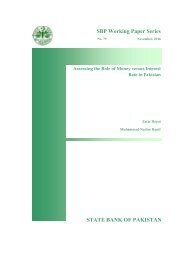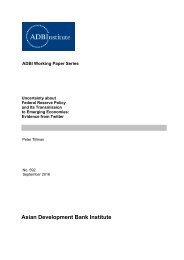SBP Working Paper Series STATE BANK OF PAKISTAN
n?u=RePEc:sbp:wpaper:74&r=mon
n?u=RePEc:sbp:wpaper:74&r=mon
Create successful ePaper yourself
Turn your PDF publications into a flip-book with our unique Google optimized e-Paper software.
t<br />
1<br />
1<br />
p<br />
*1<br />
<br />
p 1<br />
<br />
p<br />
pPt<br />
(1<br />
p)<br />
Pt<br />
P = (11)<br />
The equations (5), (7), (8), (10), (11) of production function, capital to labour ratio, marginal cost, optimal<br />
price and general price level constitute the fixed frame of our different models.<br />
3.2 Monetary Targeting Models<br />
Monetary targeting models allow explicit incorporation of money in economic decision making by<br />
households and central bank. On the basis of our empirical findings related to important role of money in<br />
explaining business cycle fluctuations, there exists a strong justification for presence of money in the<br />
model.<br />
In literature, money in utility function (MIU) and cash in advance constraint (CIA) are the two most<br />
popular approaches of creating positive money demand in general equilibrium models.<br />
MIU model assumes that holding money yields direct utility to household, even if it has no intrinsic<br />
value. As discussed in the introduction and in Table C1, C2 & C3 (see Appendix C), structural features<br />
constitute a straightforward motivation for utilizing the MIU approach. Among these features, limited<br />
access to financial services and relatively high level of currency holding are the important ones.<br />
Similarly, one may also establish the need for ‘cash-in-advance,’ which assumes that households must<br />
have stock of money available to conduct transactions related to purchase of consumption goods. The<br />
main reason for the relevance of CIA type model in Pakistan is the existence of a large informal sector<br />
which induces economic agents to conduct a large number of transactions through cash instead of<br />
cashless financial channels.<br />
Therefore, these structural features of Pakistan economy together with the empirical money-output link<br />
provides the motivation for using Money in Utility and Cash in Advance constraint models to study the<br />
role of money and monetary policy on the real side of Pakistan economy.<br />
3.2.1 Money in Utility Function (MIU) Model<br />
Originally due to Sidrauski (1967), this approach assumes that presence of real money balances yield<br />
direct utility to households. The model economy is assumed to consist of a continuum of identical<br />
households of unit mass indexed by i [0,1]<br />
. Each household i maximizes her lifetime expected utility<br />
function given by<br />
<br />
<br />
<br />
i<br />
i<br />
t i<br />
i M<br />
t<br />
U = E <br />
<br />
<br />
t<br />
lnct<br />
Aln (1 ht<br />
) Dln (12)<br />
t=0<br />
<br />
Pt<br />
<br />
i<br />
i M<br />
t i<br />
Here (0,1), c<br />
t<br />
, A,<br />
D,<br />
and h<br />
t<br />
represent discount factor, real consumption, weight of leisure in the<br />
Pt<br />
utility function, money preference, real money balances and fraction of total time spent at work<br />
respectively.<br />
The labour markets of developing economies are generally characterized by employment contracts over<br />
15






